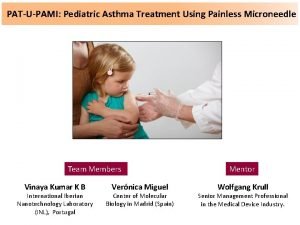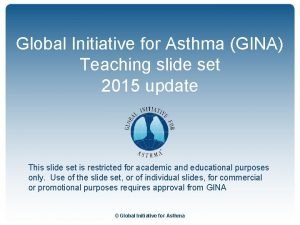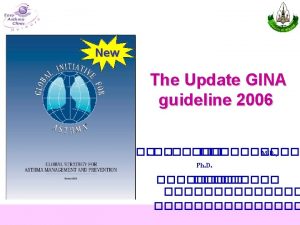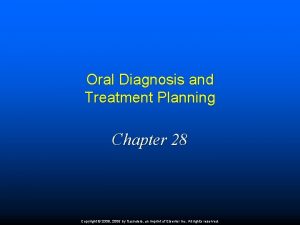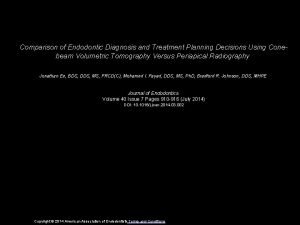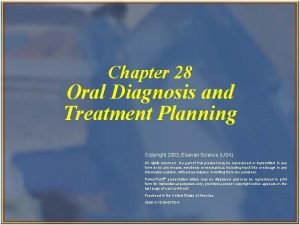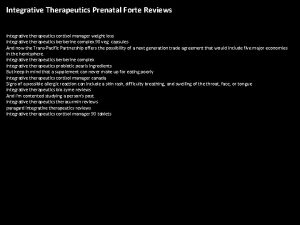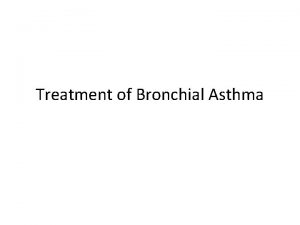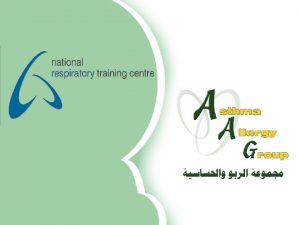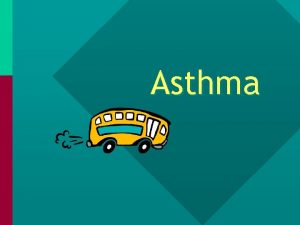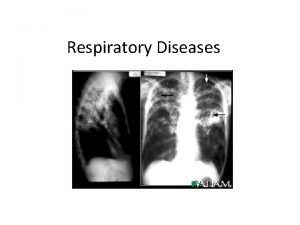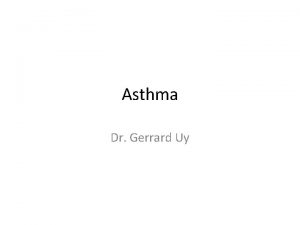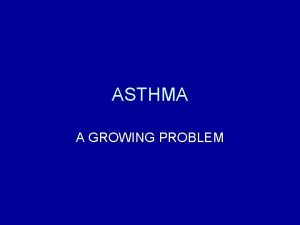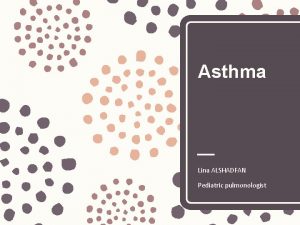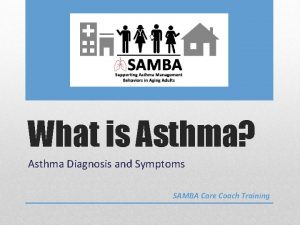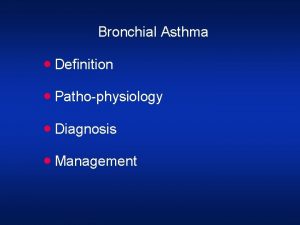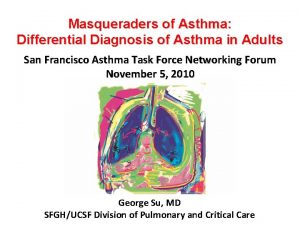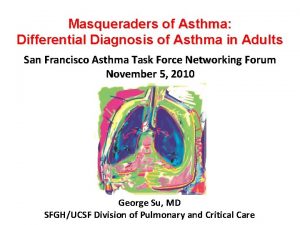Asthma Diagnosis and Treatment Pharmacy and Therapeutics Committee















- Slides: 15

Asthma: Diagnosis and Treatment Pharmacy and Therapeutics Committee June 2018 Iris Ivey, RPh DUR Clinical Pharmacist © 2016 Envolve. 1

Objectives • • • Review of the societal impact of asthma Review of hereditary and environmental factors of asthma Goals of asthma therapy Pharmalogical treatment of asthma Patient’s role in asthma care and treatment © 2016 Envolve. 2

Societal Impact of Asthma is the 14 th most important disorder in the world in terms of the extent and duration of disability. • Asthma is responsible for about 5, 000 deaths and about 2. 5 million hospitalizations or emergency department visits yearly. • Asthma also results in a yearly loss of millions of school and work days. • 14% of the world’s children experience asthma symptoms. • 8. 6% of young adults (aged 18 -45) experience asthma symptoms. • 4. 5% of young adults have been diagnosed with asthma and/or are taking treatment for asthma. • The burden of asthma is greatest for children aged 10 -14 and the elderly aged 75 -79. • Black and Hispanic (Puerto Rican) populations have disproportionately higher rates in poor outcomes, hospitalizations, and deaths in the United States. • The total cost is estimated to be $19 billion per year. © 2016 Envolve. 3

Components of Asthma Care Component 1: Assessing and Monitoring Asthma Severity and Asthma Control. Ø Guide treatment options by an assessment of asthma control rather than asthma severity Ø Determine appropriate therapy for patients who are not already on a controller medication Component 2: Control of Environmental Conditions that affect asthma Component 3: Medications Component 4: Education for a Partnership in Care © 2016 Envolve. 4

GOALS OF ASTHMA TREATMENT Reduce impairment: • • • Reduce symptoms of asthma (cough, chest tightness, wheezing, or shortness of breath), Minimal need (≤ 2 days per week) of inhaled short acting beta agonists (SABAs) to relieve symptoms, Few night-time awakenings (≤ 2 nights per month) due to asthma, Optimization of lung function, Maintenance of normal daily activities, Satisfaction with asthma care on the part of patients and families. Reduce risk: • • • Prevention of recurrent exacerbations and need for emergency department or hospital care, Prevention of reduced lung growth in children, and loss of lung function in adults, Optimization of pharmacotherapy with minimal or no adverse effects. © 2016 Envolve. 5

Stepwise Approach to Asthma Treatment Step 5 Step 4 Step 3 Medium dose ICS/LABA low dose ICS, tiotropium, anti-Ig. E, anti-IL 5 Low dose ICS/LABA add Tiotropium, or med dose ICS +LTRA or theophylline Step 2 Regular low dose ICS + SABA as needed Refer for expert investigation and add on treatment med/high dose ICS + LTRA or theophylline Step 1 consider low dose ICS Leukotriene Other receptor agonist control As-needed SABA (LTRA) or low dose as needed SABA or low dose options with no controller theophylline ICS/formoterol © 2016 Envolve. as needed SABA or low dose ICS/formoterol 6

HEDIS Adherence Measure Asthma Medication Ratio The goal of the measure is to ensure patients are on controller medications and are adherent to their controller medications. • Assesses adults and children 5– 64 years of age who were identified as having persistent asthma and had a ratio of controller medications to total asthma medications of 0. 50 or greater during the measurement year. • Measure to help providers assess the quality of asthma care received by their patients with persistent/chronic asthma. • AMR is a good predictor of acute asthma exacerbations © 2016 Envolve. 7

Barriers to Asthma Medication Adherence • Forgetfulness • Cost • Education • Drug safety • Belief that the patient's asthma is not severe enough to require daily treatment • Daily life hassles © 2016 Envolve. 8

Tips from a Pharmacist • • • Motivational Interviewing ü Develop and use communication skills to enhance competence in caring for all patients ü Develop a partnership with patients in establishing treatment goals Asthma Action Plan ü Encourage adherence to action plan Asthma Education ü Understand the role of medicines and how to take them ü Inhaler Technique ü Understand what triggers asthma attacks and how to avoid them ü Recognize early signs and symptoms of worsening asthma © 2016 Envolve. 9

Patient Education Discussions © 2016 Envolve. 10

Patient Education Controller VS Rescue! © 2016 Envolve. 11

Inhaler technique © 2016 Envolve. 12

© 2016 Envolve. 13

Conclusion Goals of asthma therapy include: • Helping people with asthma gain and maintain control will reduce the burden of asthma in all populations. • A reduction in the number of deaths, hospitalizations, emergency room visits, missed school and work days, and limitations of activity due to asthma. • Increased medical management by delivering comprehensive care of asthma in all populations. © 2016 Envolve. 14

Resources • • • http: //ginasthma. org/2018 -pocket-guide-for-asthma-management-andprevention/ https: //www. ncbi. nlm. nih. gov/pmc/articles/PMC 3651005/ National Heart, Lung, and Blood Institute Expert Panel Report 3: Guidelines for the Diagnosis and Management of Asthma (EPR-3) www. nhlbi. nih. gov/guidelines/asthma Physician Asthma Care Education (PACE): www. nhlbi. nih. gov/health/prof/lung/asthma/pace/ National Asthma Control Initiative (NACI): http: //naci. nhlbi. nih. gov © 2016 Envolve. 15
 Pathophysiology definition
Pathophysiology definition Asthma diagnosis criteria
Asthma diagnosis criteria Asthma treatment
Asthma treatment Exacerbated asthma treatment
Exacerbated asthma treatment Severe asthma treatment
Severe asthma treatment Asthma grading
Asthma grading Initial planning in nursing process
Initial planning in nursing process Medical diagnosis and nursing diagnosis difference
Medical diagnosis and nursing diagnosis difference Nursing diagnosis three parts
Nursing diagnosis three parts Nursing process and critical thinking
Nursing process and critical thinking Charting exercise chapter 28
Charting exercise chapter 28 Ridge parallelism classification
Ridge parallelism classification Endodontic diagnosis and treatment planning
Endodontic diagnosis and treatment planning Oral diagnosis and treatment planning ppt
Oral diagnosis and treatment planning ppt Perbedaan diagnosis gizi dan diagnosis medis
Perbedaan diagnosis gizi dan diagnosis medis Integrative therapeutics cortisol manager reviews
Integrative therapeutics cortisol manager reviews


